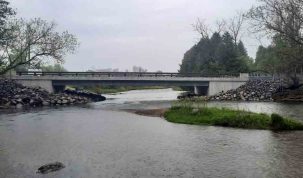By Cecilia Nasmith/Today’s Northumberland
There is still time for more input before Northumberland County council is asked to render final approval on its Natural Heritage System Plan, Land Use Planning Manager Dwayne Campbell said at the April county council meeting.
Campbell was providing a verbal update following the public meeting on this provincially required planning tool at the April 7 Economic Development, Tourism and Planning Standing Committee meeting – a session that drew some contentious comments from members of the public. The committee subsequently passed a resolution that the matter be discussed in the next session of county council.
The objectives of the plan do have widespread support in theory – “conservation, biological diversity, ecosystem services, pollination, clean water, soil-erosion control, wildlife habitat and legacy for the Northumberland County countryside,” he listed.
Furthermore, he added, this plan is required by the Ontario government to be a planning tool for the county.
“One has to remember that the NHS works in co-ordination with other planning tools – the agricultural system, the urban settlement area system, the water resources system, all these tools together to create a complete Northumberland and guide growth and development over the long term.”
Campbell acknowledged that the mapping presented at the public meeting showed a massive swath of green. Asked April 7 by Councillor Gail Latchford for a figure on how much county land falls under the NHP, he has since made the calculation – 139,772 hectares or 70.6% of the county.
“I have said it before – Northumberland County is changing,” Campbell stated.
“It’s urbanizing, and I think there’s an opportunity now to look at the countryside and start to protect that over the long term.
“That doesn’t mean that 70% of the county is now restricted from development, but rather within that 70% of the NHS there are areas identified in mapping and in policy of the most significant natural features – the largest woodlots, the wetlands – again to support the ecological integrity of the natural areas.”
Taking natural ecosystems into account in planning is not new, he pointed out. The Oak Ridges Moraine – which accounts for 20% of the county – has been a factor for a long time and will continue to be.
This applies to settlement areas as well, “where growth is directed, and in parts of the rural areas the policy and intent are staying the same It’s still required for land owners and developers to demonstrate no negative impact when proposing development.”
Similarly, he concluded, the NHS is another planning tool.
Over the past couple of years, Campbell and the consultants have spoken to hundreds of people as they worked to formulate the draft presented at the standing committee earlier this month.
“Most of them understand and appreciate the need to restrict certain forms of development in these areas,” he said.
“More recently, I have spoken with dozens and dozens of people who had direct questions about their specific property and how it is impacted by what is proposed. Almost all of them have options to continue with their development plans or future plans. In fact, of all the people I spoke with, I came across one land owner who has a lot completely covered by a significant woodlot and would have some restriction put on it.”
At this point, he noted, the province has not responded to the draft mapping and policies submitted.
The draft background report was put together in collaboration with the planning staff of member municipalities, public engagement, environmental stakeholders and Alderville First Nation.
“That, I think, is a foundation for what the NHS should be for Northumberland County,” Campbell said.
“It was endorsed by this council in 2020, and that’s where this draft policy and mapping came from. The process now is that review continue. We have started to receive public input and will continue to do so.
“There’s now the opportunity and the onus on the consultant and myself to tweak the policies where we can and come back with a final recommendation. That final recommendation will consider provincial regulation and legislation. It will have public input. It will have been reviewed by approval authorities and member municipalities that will be implementing it, and will be based on science and sound environmental-management practices.”
That presentation to council should take place in a few months, Campbell estimated, for council either to approve it and submit it to the province or to choose not to approve.
“That would jeopardize the work program for Northumberland Next and how we then move forward with the rest of the Official Plan update – and I can only speculate on the provincial response. I would suspect provincial officials would not look favourably on a municipality that did not conform to government policy,” he said.
“We are not there yet. But when we are, I think council can rest assured it will be the best policy put forward in accordance with provincial interest, but also the public interest for now and for the future.”
Councillor Bob Sanderson asked for a copy of Campbell’s comments to have on hand when constituents have questions – which are almost always about their specific plans for their own parcels of property.
Latchford also asked for county mapping that would help municipal officials give advice when these enquiries come in.
Campbell reminded council that his April 7 report is available in the archived agenda of the committee meeting, and that very good mapping can be found on the county website.
Sanderson also expressed his concern that this process is not being communicated sufficiently to members of the public. He would like to increase “the level of noise about this” so that anyone who might be affected can learn more before the process gets to its final stages.
“I am very supportive of what the goal is, but then I also want to make sure, when you go through the process, we are not faced at the end with members of the public who have issues of personal concern,” he said.
“If we can potentially up the communications, maybe to different groups – agricultural people, planning partners – I think we will end up in a very good spot.”
Noting Campbell’s comments about speaking with individual land owners, Latchford asked him if he’s open to being contacted by some of the individuals now taking their concerns to the municipalities. They can probably get their answers from information available on-line in some cases, he said, but they are also welcome to reach out to him.
Some of these cases could be a simple misunderstanding, Latchford said, but their concerns are very real. In so many cases, residents have worked hard to provide for themselves and their children, and land they can develop at some future point becomes a part of their plans.
A lot that cannot be developed is not one that can be sold, she pointed out.
“Land is such a big investment – they need that reassurance,” she said.
Sometimes it’s a simple matter of common sense, Campbell said. Common sense dictates that nobody wants to build on a wetland or in the middle of a significant woodlot.
The motion council passed in response to Campbell’s presentation asked that the verbal update be replicated in a report and that staff “investigate how clear maps may be accessed by the public and provide recommendations.”
Chief Administrative Officer Jennifer Moore suggested, in the interests of time, that this information be relayed by e-mail to councillors as soon as possible.
Councillor Brian Ostrander asked that the information go not only to the councillors, but also to the municipal planning manager of each member municipality.
























